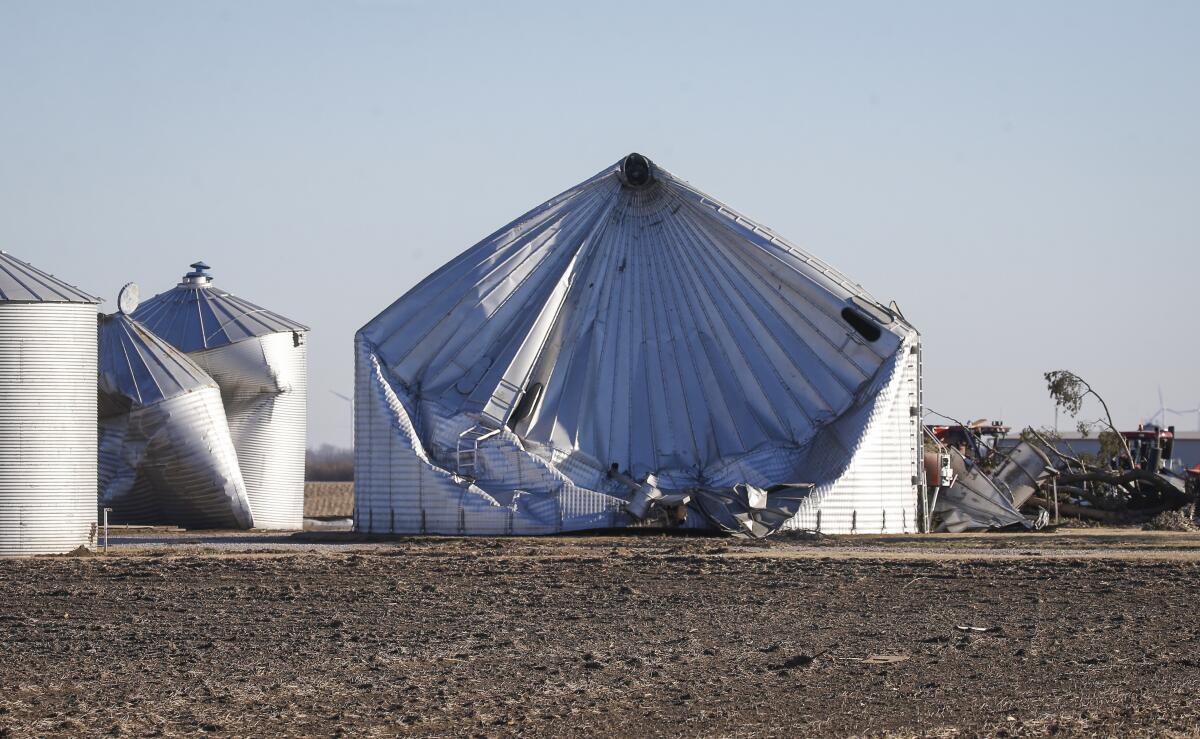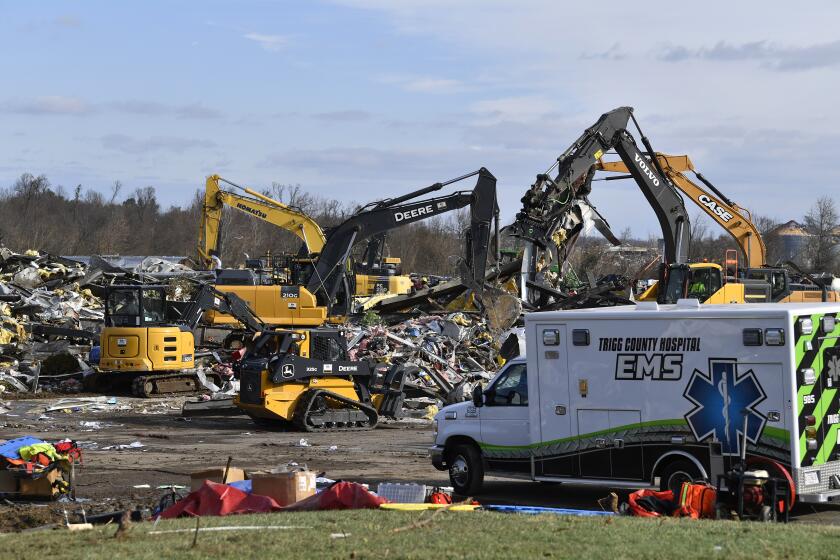At least 5 dead as storms in Midwest bring hurricane-force winds, likely tornadoes

- Share via
OMAHA — At least five people died as a powerful and extremely unusual storm system swept across the Great Plains and Midwest amid unseasonably warm temperatures, spawning hurricane-force winds and possible tornadoes in Nebraska, Iowa and Minnesota.
In southeastern Minnesota, Olmsted County Sheriff’s Lt. Lee Rossman said a 65-year-old man was killed Wednesday night when a 40-foot tree blew down on him outside his home. In southwestern Kansas, blinding dust kicked up by the storms Wednesday led to two crashes that killed three people, Kansas Highway Patrol trooper Mike Racy said. And in eastern Iowa, a semitrailer was struck by high winds and rolled onto its side Wednesday evening, killing the driver, the Iowa State Patrol confirmed.
The storm shifted north of the Great Lakes into Canada on Thursday, with high winds, snow and hazardous conditions continuing in the upper Great Lakes region, the National Weather Service said. More than 400,000 homes and businesses were without electricity in Michigan, Wisconsin, Iowa and Kansas, according to poweroutage.us, which tracks utility service disruptions.
A tornado was reported in southern Minnesota on Wednesday and, if confirmed, would be the state’s first on record in December. The small community of Hartland, Minn., might have been the hardest hit, with a reported 35 to 40 homes sustaining at least minor damage and a few businesses severely damaged, county Emergency Management Director Rich Hall said.
The destructive weather system developed amid an unprecedented warm spell for December in the Plains and northern states. That included temperatures in the 70s across southwestern Wisconsin on Wednesday evening. Weather historian Chris Burt compared the heat to that of a “warm July evening.”
“I can say with some confidence that this event (the heat and tornadoes) is among the most (if not THE most) anomalous weather event ever on record for the Upper Midwest,” Burt of Weather Co. wrote in a Facebook post.
Days after the massive storm system tore through Kentucky and five other states, some people question tornado preparation.
The winds knocked down trees, tree limbs and nearly 150 power lines in northern and western Michigan’s Lower Peninsula. In the western Michigan village of Fruitport, high winds peeled back a portion of Edgewood Elementary School’s roof, leading officials to close all district schools Thursday.
There were more than 20 tornado reports Wednesday in the Plains states, scattered mostly through eastern Nebraska and Iowa, based on preliminary reports to the Storm Prediction Center. The storm system led to the most reports of hurricane-force wind gusts — 75 mph or higher — on any day in the U.S. since 2004, the center said.
“To have this number of damaging wind storms at one time would be unusual any time of year,” said Brian Barjenbruch, a meteorologist with the National Weather Service in Valley, Neb. “But to have this happen in December is really abnormal.”
The governors of Kansas and Iowa declared states of emergency.
The system came on the heels of devastating tornadoes last weekend that cut a path through Arkansas, Missouri, Tennessee, Illinois and Kentucky, killing more than 85 people.
On Wednesday, there were at least 59 reports of hurricane-force wind gusts throughout the region, which exceeded the 53 recorded on Aug. 10, 2020, when a rare derecho wind storm struck Iowa, the Storm Prediction Center said. The destruction on Wednesday, however, was far less severe than from last year’s derecho, which caused billions of dollars of damage.
The winds also whipped up dust that reduced visibility to zero in parts of Kansas and caused at least four semitrailers to blow over, leading officials to temporarily close much of Interstate 70, as well as all state highways in nine northwestern Kansas counties.
Kansas deployed helicopters and other firefighting equipment to help smother at least a dozen wind-fueled wildfires in western and central counties, officials said Thursday.
That dust and smoke was carried north by the storm and concentrated over parts of Kansas, Nebraska and Iowa, causing a dramatic drop in air quality in those areas late Wednesday. That spawned a glut of calls to already-taxed emergency dispatchers from people reporting the smell of smoke.
The system blew into the Plains from Colorado, sending gale-force winds across a swath from New Mexico to Minnesota, Wisconsin and upper Michigan. The weather service recorded a gust of 107 mph Wednesday morning at Lamar, Colorado, and gusts of 100 mph in Russell, Kansas.
Scientists say extreme weather events and warmer temperatures are more likely to occur with human-caused climate change. However, scientifically attributing a storm system to global warming requires specific analysis and computer simulations that take time, haven’t been done and sometimes show no clear connection.
“I think we also need to stop asking the question of whether or not this event was caused by climate change,” said Northern Illinois University meteorology professor Victor Gensini. “We need to be asking, ‘`To what extent did climate change play a role and how likely was this event to occur in the absence of climate change?’”
The unusually warm temperatures on Wednesday were due in part to record high ocean temperatures in the Gulf of Mexico, which wouldn’t have happened without global warming, said Jeff Masters, a Yale Climate Connections meteorologist who cofounded Weather Underground.
Beck reported from Omaha and Stafford reported from Liberty, Mo. Associated Press writers Jill Bleed in Little Rock, Ark.; Ken Miller in Oklahoma City; Terry Wallace in Dallas; Seth Borenstein in Washington, D.C.; Jim Anderson in Denver; and Grant Schulte in Omaha contributed to this report.
More to Read
Sign up for Essential California
The most important California stories and recommendations in your inbox every morning.
You may occasionally receive promotional content from the Los Angeles Times.














